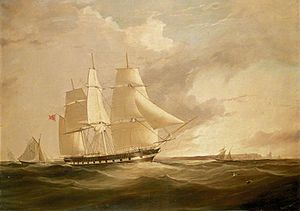Sir George Seymour (1844 ship) facts for kids
The Sir George Seymour was a sailing ship built in 1844 in Sunderland, Tyne and Wear, England. She was built by Somes Brothers. This ship was famous for carrying people across the oceans. She took convicts (people sent away as punishment) to Australia. She also carried many emigrants (people moving to a new country) to Australia and New Zealand. Sadly, a fire started on board in 1867. This fire forced her crew to leave the ship.
Contents
Voyages of the Sir George Seymour
The Sir George Seymour made several important journeys across the world. These trips helped shape the early history of Australia and New Zealand.
Carrying Convicts to Australia
On November 4, 1844, the Sir George Seymour began a long journey. Captain John Young Clarke was in charge. The ship sailed from England to Van Diemen's Land, which is now called Tasmania, Australia.
She arrived in Hobart on February 27, 1845. The ship carried 345 male convicts. She dropped off 175 convicts at Port Phillip and 169 at Hobart. Only one convict passed away during this long trip. After this, the ship sailed to Calcutta (now Kolkata) with horses and other goods.
Emigrants to Australia in 1849
In 1849, the Sir George Seymour took another group of people to Australia. She left Plymouth, England, on January 9, heading for Geelong, Victoria.
This time, she carried 302 assisted immigrants. These were people who received help to move to a new country. The ship reached Port Henry on May 14 and Melbourne on June 1. She then sailed from Sydney to Singapore and Calcutta.
Emigrants to New Zealand in 1850
The year 1850 was very important for the Sir George Seymour. She became one of the First Four Ships. These ships carried the first groups of settlers from England to the new Canterbury colony in New Zealand. This was done for the Canterbury Association.
The Sir George Seymour left Plymouth Sound, England, on September 8, 1850. She had about 227 passengers on board. On October 4, she met another ship, the Randolph. One passenger, Mr. Davy, had missed the Randolph in Plymouth. He was able to switch ships and join his own vessel.
The Sir George Seymour arrived in Port Victoria (near Lyttelton) on December 17, 1850. This was 100 days after leaving England. Sadly, two young children passed away during the journey.
The people who arrived on these first four ships are often called "The Pilgrims." Their names are carved on special plaques in Cathedral Square in the center of Christchurch.
Today, a road in Lyttelton is named George Seymour Quay. It helps remember this important ship.
Famous Passengers
Many important people traveled on the Sir George Seymour to New Zealand. They helped build the new colony.
- John Anderson (1820–1897): He later became the second mayor of Christchurch.
- John Anderson (1850–1934): His son, who also became well-known.
- Guise Brittan (1807–1876): He was the first Commissioner of Crown Lands for Canterbury.
- Emily Foster (1842–1897): His daughter, who became a teacher and school principal.
- Richard James Strachan Harman (1826–1902): A politician and businessman.
- Henry Jacobs (1824–1901): He was the first Dean of Christchurch.
- Elizabeth Watts-Russell (1833–1905): A community leader.
- John Watts-Russell (1825–1875): A politician and landowner.
The Ship's Final Journey
In 1865, the Sir George Seymour had to undergo repairs because of damage. At this time, her captain was M'Ewen. Her owner was Higgins & Co., and her homeport was London.
Two years later, in 1867, a fire destroyed the ship. The Sir George Seymour was carrying coal from Liverpool to Bombay. On December 18, 1867, the coal caught fire by itself. This is called spontaneous combustion. The fire happened at 25°S 25°W / 25°S 25°W.
The crew had to leave the burning ship. Another ship called Leda was on its way to Calcutta. The Leda rescued 15 crew members from the Sir George Seymour. The ship was completely destroyed by the fire and abandoned at sea.


